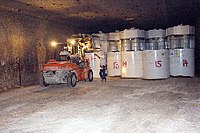
Photo from wikipedia
Industrial waste such as Ground Granulated Blast-Furnace Slag (GGBS) and Granite Waste Powder (GWP) is available in huge quantities in several states of India. These ingredients have no recognized application… Click to show full abstract
Industrial waste such as Ground Granulated Blast-Furnace Slag (GGBS) and Granite Waste Powder (GWP) is available in huge quantities in several states of India. These ingredients have no recognized application and are usually shed in landfills. This process and these materials are sources of severe environmental pollution. This industrial waste has been utilized as a binder for geopolymers, which is our primary focus. This paper presents the investigation of the optimum percentage of granite waste powder as a binder, specifically, the effect of molar and alkaline to binder (A/B) ratio on the mechanical properties of geopolymer concrete (GPC). Additionally, this study involves the use of admixture SP-340 for better performance of workability. Current work focuses on investigating the effect of a change in molarity that results in strength development in geopolymer concrete. The limits for the present work were: GGBS partially replaced by GWP up to 30%; molar ranging from 12 to 18 with the interval of 2 M; and A/B ratio of 0.30. For 16 M of GPC, a maximum slump was observed for GWP with 60 mm compared to other molar concentration. For 16 M of GPC, a maximum compressive strength (CS) was observed for GWP with 20%, of 33.95 MPa. For 16 M of GPC, a maximum STS was observed for GWP, with 20%, of 3.15 MPa. For 16 M of GPC, a maximum FS was observed for GWP, with 20%, of 4.79 MPa. Geopolymer concrete has better strength properties than conventional concrete. GPC is $13.70 costlier than conventional concrete per cubic meter.
Journal Title: Polymers
Year Published: 2022
Link to full text (if available)
Share on Social Media: Sign Up to like & get
recommendations!